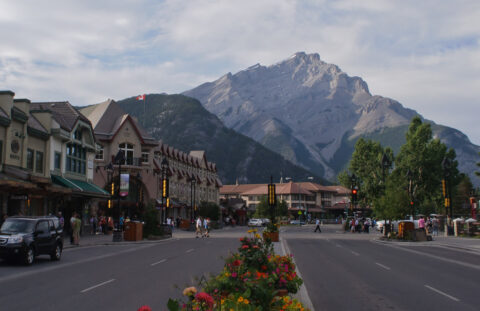I must admit I’ve never enjoyed the “tourist” experience. Partly because I’m not comfortable in big crowds and I prefer the company of a small group — or just one other person — to the “everybody into the pool” model that many people seem to thrive on. Back when we could still afford to take holidays, Elizabeth and I carefully planned our trips to avoid, as best we could, everyone else’s favourite attractions. There are some things where crowds are a given (Bourbon Street in New Orleans, anywhere in Gettysburg, Pennsylvania, everywhere in or around London, etc.) but going as early as possible or at off-peak times helps keep the people-ness down to an almost acceptable level.
In The Line, Andrew Potter relates the lowlights of a trip to wonderfully scenic Banff, Alberta (which I visited once, and it was beautiful but very, very people-y even back in the 1980s):

“Banff Avenue, Banff” by InSapphoWeTrust is licensed under CC BY-SA 2.0 .
On an early-summer family vacation to the Rockies, we decided our first excursion would be to Johnston Canyon, which tops any number of “bucket list” rankings of things to do while in Banff.
Turns out we were just four of a few thousand other people who had the same idea. Despite getting to the parking lot just after eight a.m., we spent the next few hours shuffling along a narrow boardwalk, being pushed from behind by tourbusloads of Tilley-hatted boomers while dodging around young couples dragging infants in strollers up the canyon. At each prescribed Important Sight along the way, we’d stop for 20 minutes or so while everyone took turns taking selfies in every possible permutation of their group membership.
Back at the bottom, we vowed we wouldn’t do that again, so we spent the rest of our time in the area doing hikes drawn from the very bottom of the bucket lists, skipping the alleged must-dos like the Sulphur Mountain gondola, Moraine Lake, and Lake Louise. Apparently the town of Banff is lovely, but who knows. We never set foot in it.
Tourism presents the traveller with two main dilemmas: One is what it does to us (the visitors); the other is what it does to them (the visitees). These are problems, respectively, of authenticity and commodification. And as it turns out, they are just two ways of looking at the same underlying dynamic.
For many people, the aim of travel is self-perfection. We move about the Earth in the hope of having new experiences, discovering new cultures, feeling new emotions. We want to get out of our comfort zones, out of the ruts of the familiar and experience something exotic and authentic, as a way of getting in touch with our true or better selves.
The problem is other people have the same ambitions, the same drives and desires. And this creates a market amongst “locals” for these cravings for the authentic or the exotic, which gives rise to the modern tourist industry: Get on the tour bus; see the sight; do the thing; exit through the gift shop. This can be a highly dispiriting experience, leading one to question why one bothers going anywhere, ever.



